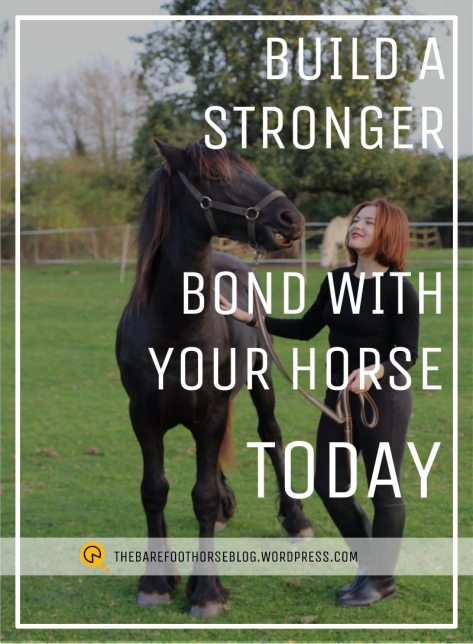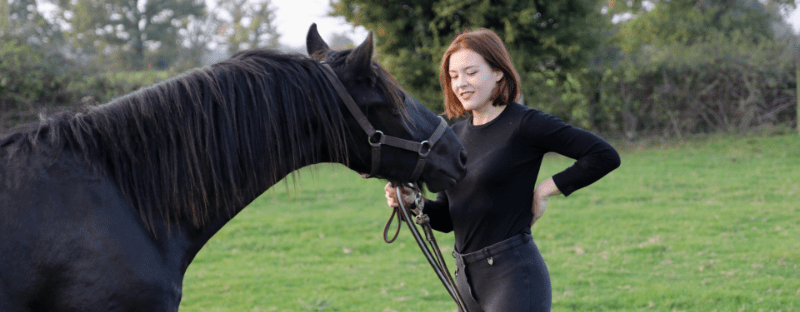Everybody wants to have a special connection with their horse. There’s something about that feeling of perfect harmony that speaks to the pony-mad eight year old hidden in all of us who love horses. I’m no exception. In my time as a horse owner I have researched and practiced many ways to get my horses to listen and respond to me both at liberty and under saddle.
It can be very difficult to get this connection and to feel like the horse is really responding to you. We often turn to extra aids and equipment like martingales and whips for many reasons – extra control or security, a more refined way to give a cue, a means of punishment. Most of us start out in riding lessons at a riding school where equipment like this is used as standard.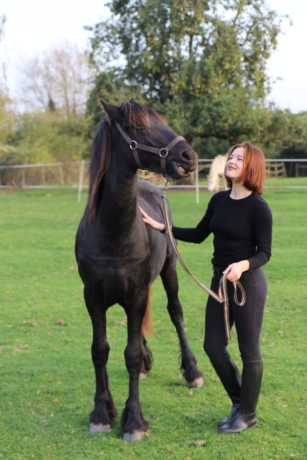
When you think about the bond you have, or want to have, with your horse, what are you hoping to achieve? The lines between communication and control become very blurred at this point – when your horse canters in circles around you at your cue, are they doing it because they want to be with you or because you are exerting a level of control over them?
Control is not necessarily a bad thing. A horse responding to commands is not necessarily being coerced into performing, but it is true that horses are very good at putting up with your crap. When working with your horse it’s really important to strike the right balance between your horse responding to a cue because they have been trained to, and them responding to the cue because they want to.
Why am I struggling to bond with my horse?
Horses are not humans, and learning to communicate effectively with your horse isn’t just like learning a new language. Two humans from opposite sides of the world at least have similar baseline responses and share similar body language. When you’re trying to communicate with your horse you’re bridging the species barrier and that’s a totally different ball game. It’s learning new responses to situations, learning to behave and react in ways that are actually quite alien to humans. It’s been a long time since humans were prey animals, and our behaviour in different situations can be totally different to horses’.
I personally don’t think trying to imitate horse body language is the best starting place for communicating with your horse. You know you aren’t a horse, the horse knows you aren’t a horse and I think it’s unrealistic to expect that the horse will 100% understand you if you just copy some horse behaviours. We wouldn’t see a lion walking up to us, baring its teeth and raising a paw as “smiling and waving”, and as a species there is no way we are good enough at body language to speak perfect Horse.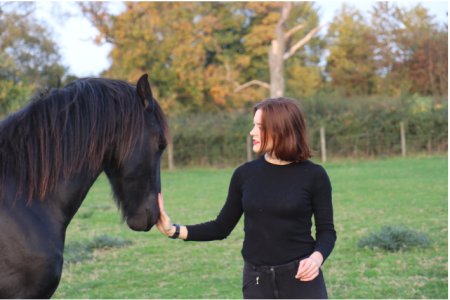
Because of this divide, we aren’t always the best at understanding what a horse is telling us. I believed for many years that licking and chewing were a sign that a horse was relaxing, when actually it’s the horse displaying anxiety signals. Anxiety behaviours can include restlessness, increased locomotion and head shaking. For example, a study by Reid et al. (2017) found that horses who were separated from their herd displayed all of these anxiety behaviours.
Tail raising, pawing at the ground and pinning the ears back are also indicators of stress (Kaiser et al, 2006). We often misread these cues as impatience, or naughty behaviour. Horses that jog along when they’re being ridden, or paw at the ground when tied up are usually told off when in reality they’re displaying symptoms of stress and anxiety.
It’s important to recognise the context these cues are being given in, as they can give you the extra information you need to understand what the horse may be feeling. Tail-swishing while being ridden is often an indicator that the horse isn’t very comfortable, but tail-swishing out in the field on a hot day is the horse getting rid of flies (although come to think of it, that’s probably because the horse isn’t comfortable there either!). A ‘hot’ horse (energetic, prancing) might just be excited to go somewhere, or it could be anxious to get to a ‘safe’ place. Understanding that a situation that we might be totally comfortable in is a situation that makes a horse anxious is the first step to effectively communicating with your horse. From there, we can start to work out what our horses are telling us, and begin to make it a two-way conversation and build the bond between horse and owner.
Bonding with your horse using Natural Horsemanship techniques
Natural Horsemanship has become hugely popular over the last decade. The emphasis with Natural Horsemanship is on using horses’ instinctive behaviours to guide your work with them. This has a number of benefits to both horse and owner.
First, it encourages the owner to learn more about their horse’s natural behaviour. The more we understand about our horses, the more we can adapt our behaviour towards them. Secondly, Natural Horsemanship focuses on a much more gentle system of training, with emphasis placed on positive reinforcement rather than positive punishment. To read more about reinforcement and punishment, see my previous post on the behavioural approach to learning.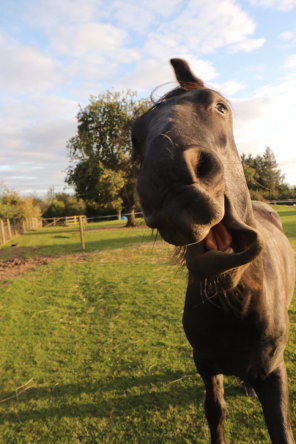
However, Natural Horsemanship isn’t without its downsides. The key principle of Natural Horsemanship is that the human tries to mimic horse behaviour and establish themselves as ‘leader of the herd’. Research has shown that the relationship between horses and humans is far more complex than we might think, and horses behave differently towards humans than they do to other horses. It’s not always a conscious response either, a horse’s heart rate will actually increase as their rider’s heart rate increases. This is probably where we get the idea that horses can smell fear on a human (although they use smell to assess us too) – they’re responding to our unconscious stress signals and changing their behaviour accordingly.
Some of the most widely-publicised and used Natural Horsemanship techniques may not be all they’re cracked up to be either. Take join up for example. Join up was developed by Monty Roberts as a way to establish yourself as the dominant ‘herd leader’ in order to get your horse to listen to you. Great emphasis is placed on how sensitively the horse will respond to you and how strong the bond formed by practicing join up is. In 2012, a study found that you can do join up using a remote controlled car in place of a human and get the exact same response. Also, the signals used to determine when a horse is ready to completely ‘join up’ are stress indicators suggesting that the horse would really like to stop being chased.
Personally, I don’t think join up is a good way to train your horse. On the occasions I have tried or watched it, I have seen stressed and sometimes panicked horses who are plainly not ‘submitting’ because they recognise you as their leader, but because they have worked out that they won’t be harassed by you if they just stand quietly by your side. Also, the only time I have ever had issues catching one of my horses from the field is after I have tried a join up session with them. It may work for some horses, but I don’t think it’s because they are recognising the human as herd leader.
How do I bond with my horse?
So how should you bond with your horse? Probably the most important thing to do is to spend time with them. This doesn’t have to be structured training time – just hanging out with them, getting comfortable being around each other is just as important. If you’re comfortable with your horse in the field, groom them outside, wander around for a bit with them and let them know that they can trust you. This sort of
time together is useful for learning to read your horse. They will become comfortable with you in their field (or stable) and you will start to pick up on what behaviours they exhibit when they’re relaxed, sleepy, happy, playful, grumpy. A lot of the tack and equipment we use doesn’t allow a horse to express these emotions clearly, and a horse might suppress their behaviour when being ridden as well so spending time without the tack is just as important as training with the tack.
When it comes to training, don’t be afraid of making it enjoyable for the horse. Many people think you shouldn’t use treats to train your horse, despite there being a lot of evidence that horses respond well to treats. My Welsh pony, Honey, is a certified biter who will push and barge and do everything she can to avoid trying to learn things she finds stressful. When I first got her, she actively resisted me picking up her front feet and wouldn’t let me pick up her hind feet at all (she’d never been taught to and simply fell over whenever a back foot was lifted off the ground). Through a combination of positive reinforcement (treats when she lifted her foot up) and positive punishment (a tap on the belly when she tried to bite me) I had her picking up her feet in two weeks. I’m still immensely proud of this achievement (can you tell?) and it suggests to me that we shouldn’t be so wary of giving treats to horses to reinforce the praise we give them as well. A horse doesn’t necessarily get the immediate ‘reward’ feeling when you tell them they’re a good horse in the same way that they do when they get a carrot.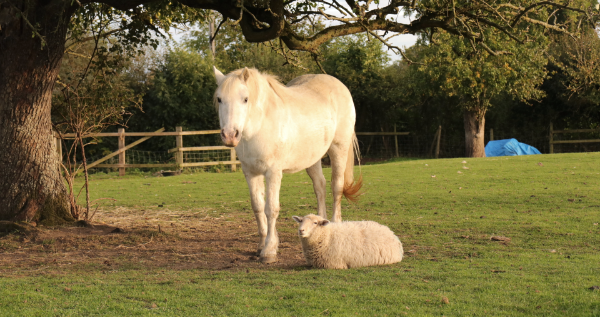
In the long term, this system of spending time with Honey and making work a pleasant experience for her meant that I have developed a strong bond with this pony. We won’t be managing any wonderful performances at liberty but I know exactly what I can trust her with and I am pretty good at knowing when she needs some comfort in a situation and when she is just fine on her own.
To make all this even easier, look at how you can make your horse’s day-to-day living environment better. Most research shows that horses are less stressed when they have plenty of access to turnout and are kept around other horses and allowed to form social bonds – basically all the things that make humans less stressed. This is summed up really nicely in a recent blog post by Lauren Fraser CHBC. It’s important to also give your horse time off to unwind and relax. This doesn’t mean that they need weeks, or even days, of rest between sessions of work as that may actually slow down their ability to learn, but they do need time to process any training you’re doing with them.
The secret to bonding with your horse
There’s no one right way to do build a stronger bond with your horse. Every horse is an individual, and every owner is an individual too. Learning as much as you can not only about horse behaviour, but how horses behave in relation to humans is probably the most important first step to take. From there, it’s a slow process of watching your horse and trying to work out why and how they react to things. The more time you spend with your horse the better you will understand them and the better you will get at giving them the right cues for the right responses.
It may be a slow process, but I believe everyone can have a strong bond with their horse. A lot of it simply comes down to how well you know them, and that only comes with time and patience.
I hope you found something interesting in this post, and if you liked it a lot (or if you really, really hated it) please leave a comment!
